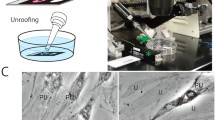Abstract
The recent data explosion in global gene expression profiling and proteomics has resulted in a need to determine the mechanistic role of biomarker signatures in pathogenicity. Consequently, elaborate technologies are required to assess increasingly smaller sub-cellular compartments and constituents. We describe the development, evaluation and application of an efficient sample preparation methodology to facilitate coupled atomic force microscopy and confocal laser scanning microscopy (AFM–CLSM), providing a novel means of concurrent high-resolution structural and fluorescence imaging. Due to their fragile nature and nanoscale dimensions, filopodia were selected as a model to develop the procedure that maximised fluorescence response, while maintaining epithelial cell ultra-structure. Fixation with ultra-pure methanol-free formaldehyde coupled to quantum dot nanocrystal labelling proved to be vital in achieving high quality AFM–CLSM images. We demonstrated for the first time that filopodia have a “quilted” surface structure. Additionally, high ultra-structural ridges on the apical cell surface resolved by AFM corresponded to punctate moesin clusters, representing direct visualisation of moesin linkages between transmembrane proteins and the cytoskeleton. The capacity of this novel multi-modal imaging technique to probe topography, molecular composition and biophysical properties of ultra-structural features therefore provides unique information that will significantly contribute to our understanding of cellular structure–function relationships.




Similar content being viewed by others
References
Amieva MR, Furthmayr H (1995) Subcellular-localization of moesin in dynamic filopodia, retraction fibers and other structures involved in substrate exploration, attachment and cell–cell contacts. Exp Cell Res 219:180–196
Borm B, Born S, Merkel R, Hoffmann B (2007) Role of filopodia in adhesion formation during migration of epithelial cells. From computational biophysics to systems biology, vol 36, Publication Series of the John von Neumann Institute for Computing, pp 159–163
Bowen WR, Lovitt RW, Wright CJ (2000) Application of atomic force microscopy to the study of micromechanical properties of biological materials. Biotech Lett 22:893–903
Butt HJ, Cappella B, Kappl M (2005) Force measurements with the atomic force microscope: technique, interpretation and applications. Surf Sci Rep 59:1–152
Crampton N, Bonass WA, Kirkham J, Rivetti C, Thomson NH (2006) Collision events between RNA polymerases in convergent transcription studied by atomic force microscopy. Nucleic Acid Res 34:5416–5425
Davies E, Teng KS, Conlan RS, Wilks SP (2005) Ultra-high resolution imaging of DNA and nucleosomes using non-contact atomic force microscopy. FEBS Lett 579:1702–1706
Edwards KA, Demsky M, Montague RA, Weymouth N, Kiehart DP (1997) GFP-moesin illuminates actin cytoskeleton dynamics in living tissue and demonstrates cell shape changes during morphogenesis in drosophila. Dev Biol 191:103–117
Engel A, Schoenenberger CA, Muller DJ (1997) High resolution imaging of native biological sample surfaces using scanning probe microscopy. Curr Opin Struct Biol 7:279–284
Jaiswal JK, Simon SM (2004) Potentials and pitfalls of fluorescent quantum dots for biological imaging. Trends Cell Biol 14:497–504
Kassies R, Van Der Werf KO, Lenferink A, Hunter CN, Olsen JD, Subramaniam V, Otto C (2005) Combined AFM and confocal fluorescence microscope for applications in bio-nanotechnology. J Microsc 217:109–116
Kellermeyer SZ, Karsai A, Kengyel A, Nagy A, Bianco P, Huber T, Kulcsar A, Niedetzky C, Proksch R, Grama L (2006) Spatially and temporally synchronized atomic force and total internal reflection fluorescence microscopy for imaging and manipulating cells and biomolecules. Biophys J 91:2665–2677
Kiernan JA (2000) Formaldehyde, formalin, paraformaldehyde and glutaraldehyde: what they are and what they do. Microsc Today 8:8–12
Kramer A, Ludwig Y, Shahin V, Oberleithner H (2007) A pathway separate from the central channel through the nuclear pore complex for inorganic ions and small macromolecules. J Biol Chem 282:31437–31443
Lee S, Mandic J, Van Vliet KJ (2007) Chemomechanical mapping of ligand-receptor binding kinetics on cells. PNAS 104:9609–9614
Medintz IL, Uyeda HT, Goldman ER, Mattoussi H (2005) Quantum dots bioconjugates for imaging, labelling and sensing. Nat Mater 4:435–446
Nakamura F (2001) Biochemical, electron microscopic and immunohistological observations of cationic detergent-extracted cells: detection and improved preservation of microextensions and ultramicroextensions. BMC Cell Biol 2: article 10
Owen RJ, Heyes CD, Knebel D, Rocker C, Nienhaus GU (2006) An integrated instrumental setup for the combination of atomic force microscopy with optical spectroscopy. Biopolymers 82:410–414
Pfister G, Stroh CM, Perschinka H, Kind M, Knoflach M, Hinterdorfer P, Wick G (2005) Detection of HSP60 on the membrane surface of stressed human endothelial cells by atomic force microscopy and confocal microscopy. J Cell Sci 118:1587–1594
Poole K, Muller D (2005) Flexible, actin-based ridges colocalise with the beta 1 integrin on the surface of melanoma cells. Br J Cancer 92:1499–1505
Speck O, Hughes SC, Noren NK, Kulikauskas RM, Fehon RG (2003) Moesin functions antagonistically to the Rho pathway to maintain epithelial integrity. Nature 421:83–87
Vasioukhin V, Bauer C, Yin M, Fuchs E (2000) Directed actin polymerization is the driving force for epithelial cell–cell adhesion. Cell 100:209–219
Acknowledgments
B. Jones and L. Francis were supported by funds from the European Union–European Social Fund. The Engineering and Physical Sciences Research Council provided funds for the development of the AFM–CLSM system (C. Wright). SH Doak is currently supported by a Research Councils UK Fellowship.
Author information
Authors and Affiliations
Corresponding author
Rights and permissions
About this article
Cite this article
Doak, S.H., Rogers, D., Jones, B. et al. High-resolution imaging using a novel atomic force microscope and confocal laser scanning microscope hybrid instrument: essential sample preparation aspects. Histochem Cell Biol 130, 909–916 (2008). https://doi.org/10.1007/s00418-008-0489-5
Accepted:
Published:
Issue Date:
DOI: https://doi.org/10.1007/s00418-008-0489-5




